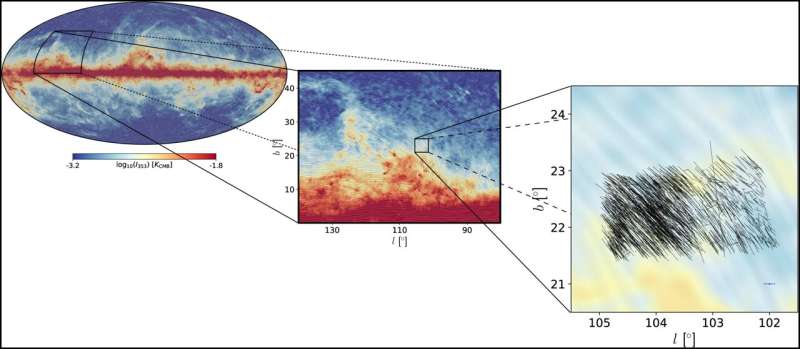
Sky location of the surveyed area of about four square degrees. Left: full-sky map of the dust emission Middle: a zoom-in of the map toward the surveyed regions, which includes part of the North Celestial Pole Loop on the East of the map. Right: a closer view of the surveyed region. Black segments indicate the polarization orientation from the stars in our survey. Credit: Astronomy & Astrophysics (2024). DOI: 10.1051/0004-6361/202349015
We are all very familiar with the concept of the Earth’s magnetic field. It turns out that most objects in space have magnetic fields but it’s quite tricky to measure them. Astronomers have developed an ingenious way to measure the magnetic field of the Milky Way using polarized light from interstellar dust grains that align themselves to the magnetic field lines. A new survey has begun this mapping process and has mapped an area that covers the equivalent of 15 times the full moon.
Many people will remember experiments in school with iron filings and bar magnets to unveil their magnetic field. It’s not quite so easy to capture the magnetic field of the Milky Way though. The new method to measure the field relies upon the small dust grains which permeate space between the stars.
The grains of dust are similar in size to smoke particles but they are not spherical. Just like a boat turning itself into the current, the dust particles’ long axis tends to align with the local magnetic field. As they do, they emit a glow in the same frequency as the cosmic background radiation and it is this that astronomers have been tuning in to.
Not only do the particles glow but they also absorb starlight that passes through them just like polarizing filters. The polarization of light is familiar to photographers that might use polarizing filters to darken skies and manage reflections. The phenomenon of polarization refers to the propagation of light. As it moves through a medium it carries energy from one place to another but on the way it displays wave like characteristics.
The wave nature is made up of alternating displacements of the medium through which they are traveling (imagine a wave in water). The displacement is not always the same as the direction of travel; sometimes it is parallel and at other times it is perpendicular. In polarization, the displacement is limited to one direction only.
In the particles in interstellar space, the polarizing properties capture the magnetic field and polarize the light that travels through them revealing the details of the magnetic field. Just as they are on Earth, magnetic field lines are of crucial importance to galactic evolution. They regulate star formation, shape the structure of a galaxy and like gigantic galactic rivers, shape and direct the flow of gas around the galaxy.
Researchers from the Inter-University Institute for High Energies in Belgium used the PASIPHAE survey—an international collaboration to explore the magnetic field from the polarization in interstellar dust—to start the process. They measured the polarization of more than 1,500 stars which covered an area of the sky no more than 15 times the size of the full moon.
The team then used data from the Gaia astrometry satellite and a new algorithm to map the magnetic fields in the galaxy in that part of the sky. The study is published in the journal Astronomy & Astrophysics.
This is the first time that any large scale project has attempted to map the gravitational field of the Milky Way. It will take some time to complete the full mapping but it when complete it will provide great insight not just into the magnetic field of galaxies but to the evolution of galaxies across the universe.
More information:
V. Pelgrims et al, The first degree-scale starlight-polarization-based tomography map of the magnetized interstellar medium, Astronomy & Astrophysics (2024). DOI: 10.1051/0004-6361/202349015
Citation:
Mapping the Milky Way’s magnetic field in 3D (2024, April 27)
retrieved 28 April 2024
from https://phys.org/news/2024-04-milky-magnetic-field-3d.html
This document is subject to copyright. Apart from any fair dealing for the purpose of private study or research, no
part may be reproduced without the written permission. The content is provided for information purposes only.
>>> Read full article>>>
Copyright for syndicated content belongs to the linked Source : Phys.org – https://phys.org/news/2024-04-milky-magnetic-field-3d.html
